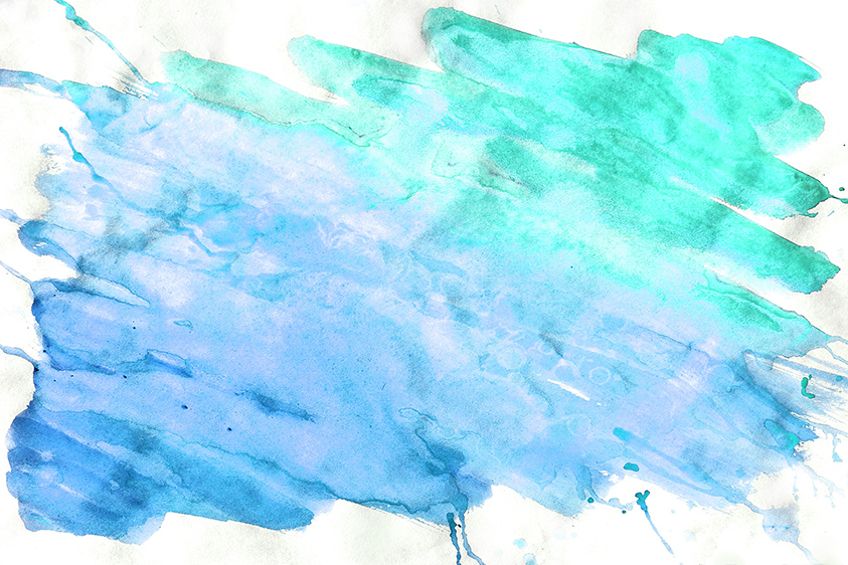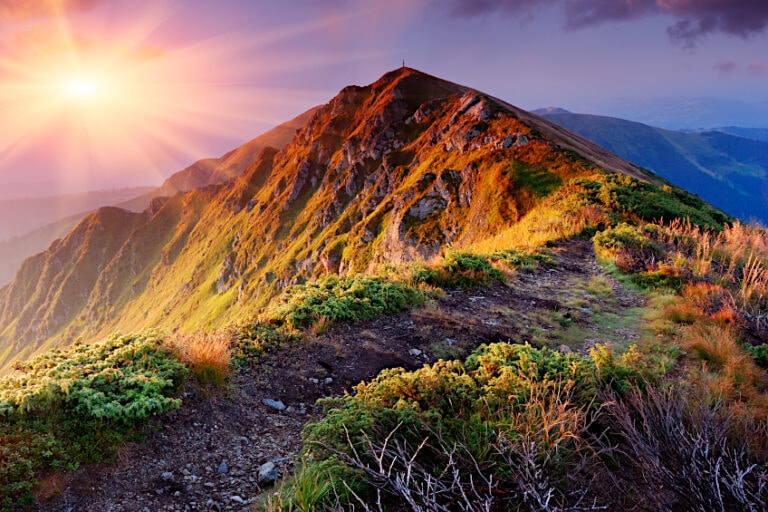What Colors Make Turquoise? – How to Mix Different Shades of Turquoise
This post may contain affiliate links. We may earn a small commission from purchases made through them, at no additional cost to you.
When you think about the color turquoise, do you think of it as a shade of blue or is it more of a green? This beautiful color is loved by many and is the result when you mix blue and green. There are also so many shades of turquoise, just think of the bright turquoise ocean in a tropical location, for example! Of course, many shades of turquoise are associated with calmness and serenity. If you have been thinking about painting a feature wall in your home with turquoise paint, you may also be thinking about what colors make turquoise, or perhaps how to make aqua or how to make teal. Our guide that follows will answer any questions you may have about all the gorgeous and varying shades of turquoise!
Table of Contents
A Short History of Turquoise
Before we get into what colors make turquoise and more about turquoise paint, let us learn a bit more about how to simply mix blue and green color shades! The word “turquoise” is quite an old one. In fact, it goes as far back as the seventeenth century! It is actually the French word for “Turkish”. Turquoise was mined in some areas of Ancient Egypt first, and then from turquoise mines in Persia (Iran today) and Afghanistan.
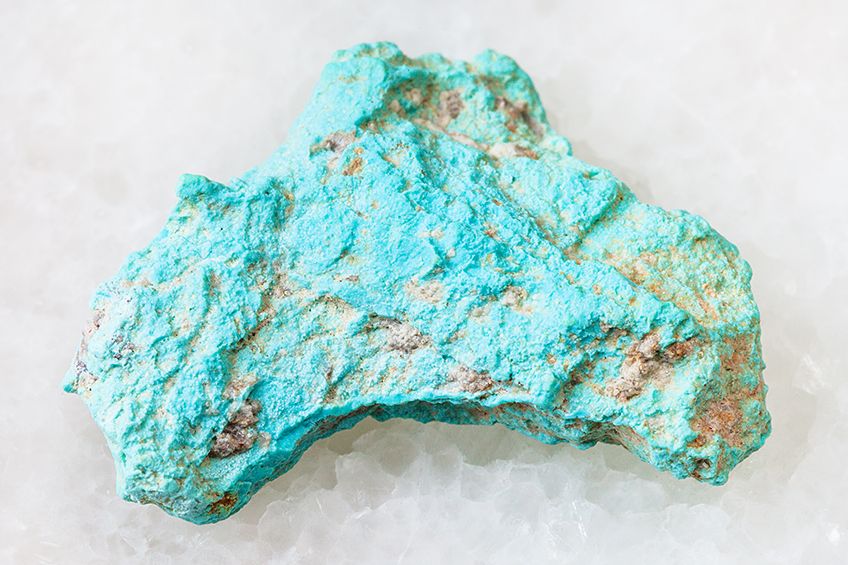
While being exported to Europe, it went via Turkey. The turquoise stone also dates back prehistorically, as in Bulgaria artifacts made from and with the stone have been found. This indicates that turquoise has been prized for a very long time indeed. The color itself has been noted to be a shade of cyan back in the early 1500s. A real turquoise stone has always been sought after, thanks to its beautiful mix of blue and green colors. It is often used in jewelry and has always been considered a stone for the wealthy, indicating how prosperous and stylish they were.
Beautiful bright Turquoise is exotic in appearance, making it seem quite mystical and almost magical. The Native Americans also mined this stone in the New Mexico and Arizona regions of America.
Turquoise was not just a stone for the Native Americans, but a symbol of protection. The Apaches liked to ensure a piece of turquoise was always on their person to make sure they had perfect aim when hunting with a bow and arrow. Even the Aztecs used this beautiful stone in many objects! Thanks to its vast history, turquoise is considered to be a symbol of many positive things. It represents hope, balance, calm, success and as stated above, protection.
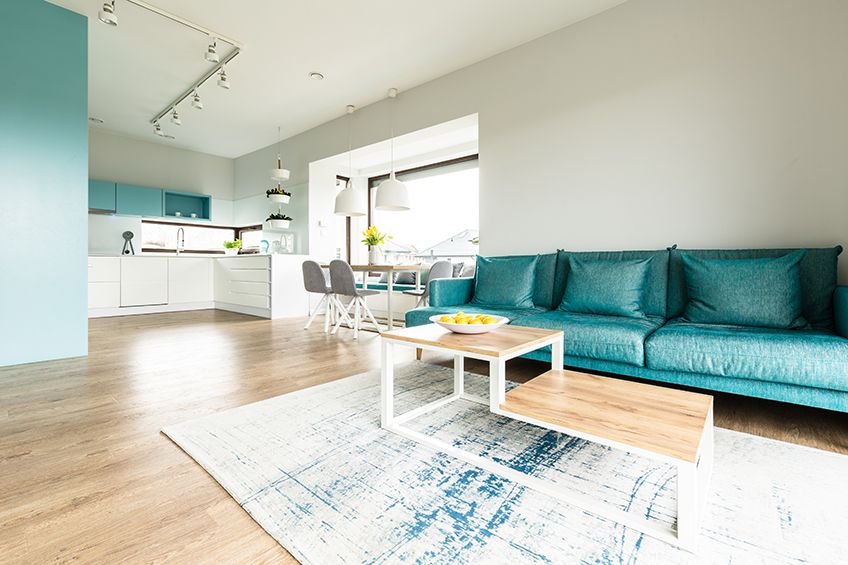
Decembers’ birthstone is none other than beautiful bright turquoise! Of course, there is a lot of fake turquoise on the market, thanks to the real stone being so expensive. If you have a little bit of color theory knowledge, you will probably understand what colors make turquoise already, however, let us delve into how to mix turquoise and all the shades of turquoise!
What Two Colors Make Turquoise?
If you have been looking to add some brightness to your life or art project, shades of turquoise could be exactly what you are looking for! But the question remains: is learning how to mix turquoise as simple and easy as it sounds? Simply mix blue and green, right? However, it is not always that simple, and making turquoise in the perfect shade can actually prove to be a bit more challenging!
You may need to add a little more of a different color in order to get that perfect shade of turquoise paint. When looking at the color wheel, the color itself is considered to be somewhat in the middle of blue and green.
Remember that when you are busy creating your palette for turquoise, you will need to do a bit of experimentation and a mix of blue and green and possibly some other colors as well. In order to create various shades of turquoise, you will need a basic understanding of color theory. Using a color wheel is helpful with this and will be vital when creating your turquoise paint and all the beautiful shades of turquoise!
Learning About Color Temperature
Every color is either associated with being warm or cool or having a color bias. Orange, red, and yellow are obviously considered to be warmer colors, while blue and green are cool colors. That said, you also get shades of blue which are warmer, and shades of orange that are cooler. This also applies to turquoise, and because it is created from a mix of blue and green, turquoise has a color bias too.
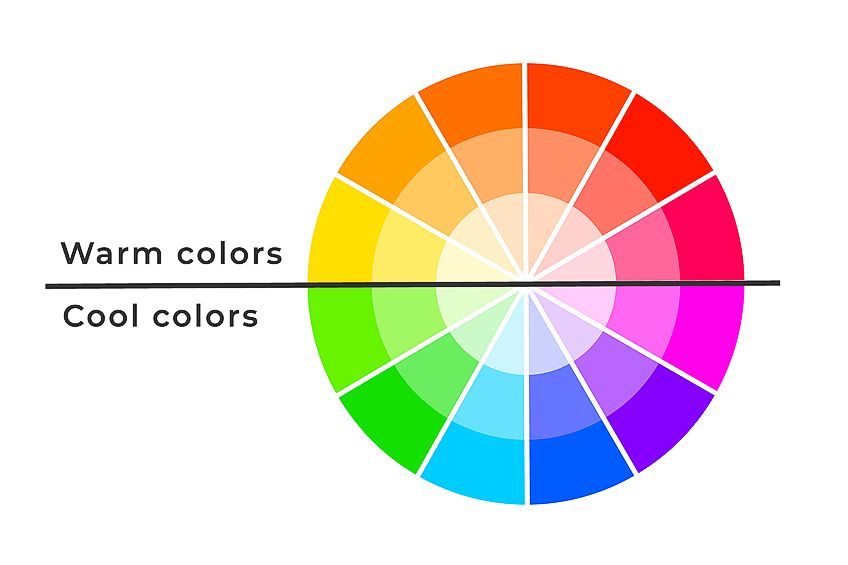
Green is made by mixing and blending yellow and blue. When you add more yellow, you create a warmer green, as when adding more blue, you create a cooler shade. Some warmer blue shades have a purple bias more so than green. A cooler shade of blue has a green bias. There is so much more to what colors make turquoise than can be seen to the naked eye! If you want to mix the perfect shade of turquoise paint, you will need to start off with the right tones and shades of blue and green.
The Various Shades of Turquoise and Tints
When you mix your own color, you can not only create the exact temperature you want, but you can mute the color, make it a bit darker or a bit brighter. If you want to create bright turquoise, you will want to add some more yellow. It should be noted that if you use white to create more brightness, you could create a more muted or opaque turquoise. This is called making a tint.
Shades of turquoise are made by adding darker colors such as black to your mix of paint. Therefore, adding more white paint or more black paint will determine what your shade or tint is.
Remember to always add the tiniest amounts as you go, to make sure you do not add too much color and ruin it with too much of the wrong color. Black is such a severe color and can easily mess up your mix. It might be a better idea to use a navy blue rather than black when making your turquoise darker. You could even use a bit of purple if you want to create a more distinctive shade of turquoise. The key is always experimentation!
Colors That Complement The Shades of Turquoise
Looking now at our nifty color wheel, we can see that all the colors are in a circle. You can now see which colors complement one another, as these colors are shown opposite one another. A good example of this would be blue and orange. When searching for the right color to complement turquoise, yellow, orange, and red would be ideal. You may want to use a more golden and rich shade as well.
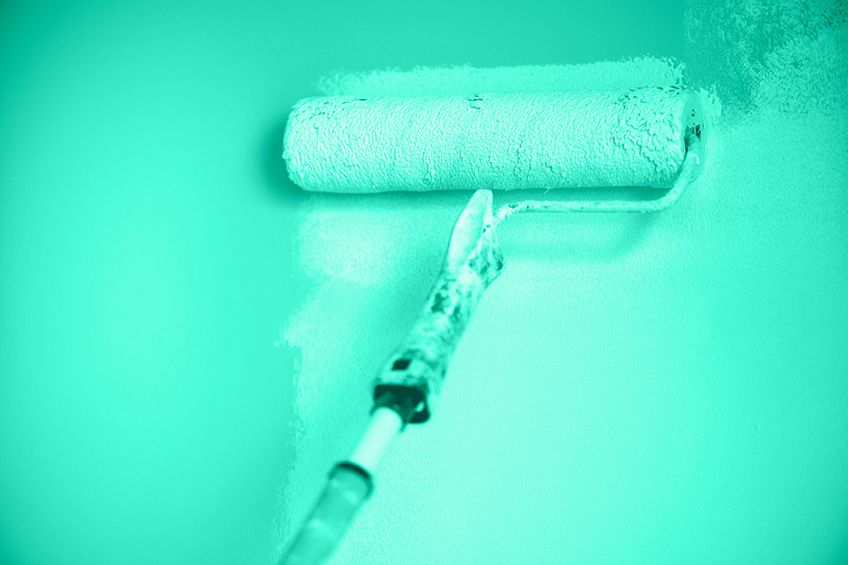
The color turquoise will appear bolder and more intense when placed next to one of its complementary colors. Remember, you can not blend complementary colors unless of course, you are hoping to achieve a muddy brown! You can also pair a lighter or paler turquoise with white, tan or gray, or even shades of brown.
The Most Popular Shades of Turquoise
Often, it is subjective when naming a color or describing it. Would you consider beige to be a standard color? Many people consider beige to be light brown. When it comes to turquoise, the case is the same. Many people consider teal to be a shade of turquoise. The same can be said for aqua blue. When getting technical, teal is actually a darker version of turquoise, but the aqua is far bluer, with a little bit of green.
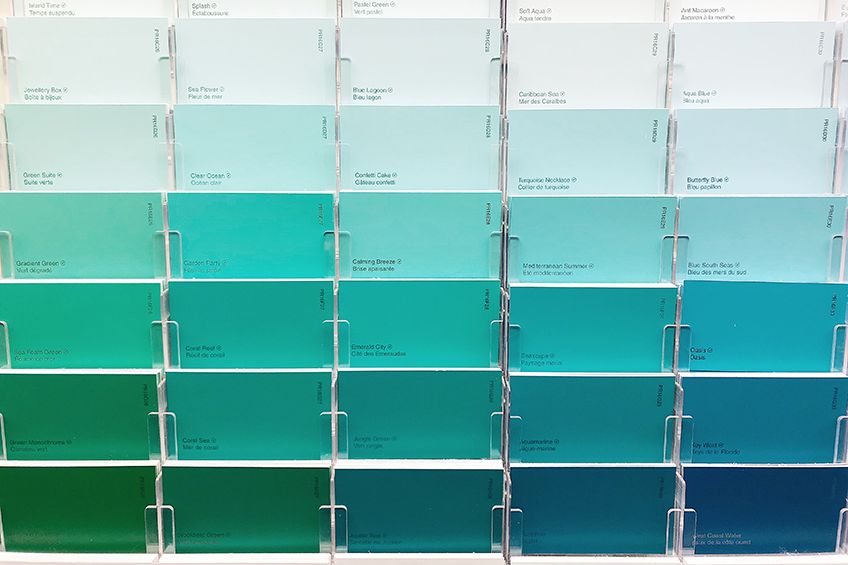
There are so many tools available to you and everyone out there when printing and using computer graphics. Hex codes represent various colors and how much red, green, and blue are in the color. This is known as RGB. When printing colors, four colors are used, cyan, yellow, magenta, and black. This is known as CMYK.
To follow next is our list of favorite shades of turquoise, along with handy tables for each color which will tell you exactly what % of color is in each and what the hex codes are.
Turquoise
You could consider turquoise to be a bright cyan color. A mix of green and blue, it gives off a wonderful calm feeling. Some people may refer to turquoise as aquamarine. The truth is, they are both completely different colors! Aquamarine is a lot bluer, with some hints of green. It is often used when painting the ocean. Turquoise, on the other hand, is a greenish-blue.
| Color Name | Shade of Turquoise | Hex Code | RGB % | CMYK % |
| Turquoise | 40e0d0 | 25.1, 87.8, 81.6 | 71, 0, 7, 12 |
Blue-Green Turquoise
This version of turquoise is a much stronger cyan in color. It still holds its calm and peaceful effect. It is more blue-green and you may find this shade in the Crayola crayon box! In nature, blue-green turquoise is seen in many places, for example, lakes or even fish. Take for example the damselfish. A wonderful showing of blue-green turquoise! If you are painting a glacier-type scene, you might want to consider the combination of blue-green and light blue as well as some white. If you want the color to pop and stand out, pair it with oranges and yellows.
| Color Name | Shade of Turquoise | Hex Code | RGB % | CMYK % |
| Blue-Green | 0d98ba | 5.1, 59.6, 72.9 | 93, 18, 0, 27 |
Celeste Turquoise
A lighter and paler cyan, inspired by the skies on a hot and cloudless summer day. Celeste turquoise is exactly as it sounds. While the ideal and perfect shade of this tone has changed ever so slightly over the years to become a bit more of a minty color, it is still the perfect “sky blue”.
| Color Name | Shade of Turquoise | Hex Code | RGB % | CMYK % |
| Celeste | b2ffff | 69.8, 100, 100 | 30, 0, 0, 0 |
Electric Blue Turquoise
In the mid-1840s, electric blue was used as a color name by the English. It is a color with energy and a real excitement about it. It is often used rather than a blue that is more muted and works very well with white. When using other vibrant hues such as a lovely bright orange-red, you can create a palate that is especially striking to the eye. And just like other turquoise shades, it even blends well and works nicely with other blue shades.
| Color Name | Shade of Turquoise | Hex Code | RGB % | CMYK % |
| Electric Blue | 7df9ff | 49, 97.6, 100 | 51, 2, 0, 0 |
Turquoise Green
Somewhat a desaturated cyan-lime green color, turquoise green is often used to represent freshness and calmness. The best complementary color for this shade of turquoise is a desaturated pink. That said, it also blends beautifully with other muted or desaturated shades of green and blue.
| Color Name | Shade of Turquoise | Hex Code | RGB % | CMYK % |
| Turquoise Green | a0d6b4 | 62.7, 83.9, 70.6 | 25, 0, 16, 16 |
Tiffany Turquoise
Tiffany turquoise came into existence around the mid-19840s. The color was created for Charles Lewis Tiffany’s jewelry packaging. As the color gained popularity and fame, it was aptly named Tiffany blue. If you are looking for elegance, this is a good shade of turquoise to use. It also pairs very well with corals, yellow and deeper blue.
| Color Name | Shade of Turquoise | Hex Code | RGB % | CMYK % |
| Tiffany | 0abab5 | 3.9, 72.9, 71 | 95, 0, 3, 27 |
Keppel Turquoise
This turquoise shade is known as Keppel. It is a darker and more saturated cyan with gray undertones. Keppel turquoise is a lovely calming shade and represents creativity and intelligence. Many businesses like to use this shade of turquoise, including airlines and hospitals. This color is also used when painting the sky or an oceanic scene.
| Color Name | Shade of Turquoise | Hex Code | RGB % | CMYK % |
| Keppel | 3ab09e | 22.7, 69, 62 | 67, 0, 10, 31 |
Light Sea Green Turquoise
A darker cyan, light sea green turquoise is clearly ocean-inspired! This shade has more green in it than it does blue. It shows up beautifully against a dark and desaturated red or even white. You can blend it well with a darker shade of cyan-lime green or dark blue.
| Color Name | Shade of Turquoise | Hex Code | RGB % | CMYK % |
| Light Sea Green | 20b2aa | 12.5, 69.8, 66.7 | 82, 0, 4, 30 |
Teal Turquoise
Clarity and calm are the order of the day, especially when it comes to teal. Connected to nature and water. If you want to create a lovely sophisticated contrast, pair this shade with a lovely deep maroon or other green shades.
| Color Name | Shade of Turquoise | Hex Code | RGB % | CMYK % |
| Teal | 008080 | 0, 50.2, 50.2 | 100, 0, 0, 50 |
Catalina Turquoise
Catalina turquoise is a more muted, dark cyan tone. As with most shades of blue, it is again representative of thoughtfulness, calmness, and of course, serenity. You can pair this color well with a muted dark red or other muted dark blues or greens.
| Color Name | Shade of Turquoise | Hex Code | RGB % | CMYK % |
| Catalina | 72a49f | 44.7, 64.3, 62.4 | 30, 0, 3, 36 |
How to Mix Turquoise Paint
When you are learning what two colors make turquoise and how to mix the various tones of turquoise paint, be it muted or bright turquoise, you will probably find that choosing a turquoise color paint right from the get-go is the easiest way forward. That said, you might want to change that color ever so slightly, read on if you are wanting to learn how to mix your own turquoise paint.
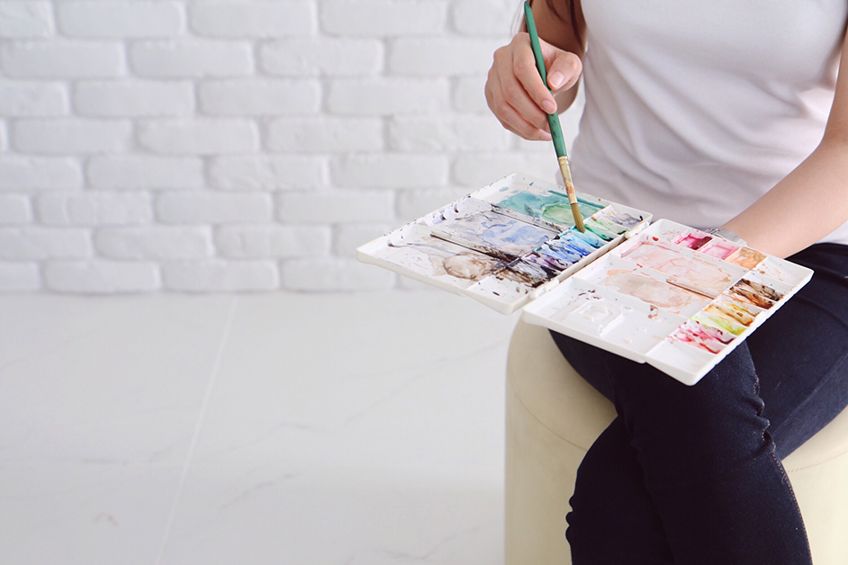
Things to Consider When Buying Paint Colors
Grab some green and some blue paint, oil, acrylic, or watercolor, whatever your medium of choice! When you first start mixing colors and experimenting, you may find acrylic is the easiest to work with. You can check online reviews and find a good paint brand to suit your needs and budget. Remember to try to choose a blue shade with a green bias.
When you want to brighten up or lighten your turquoise shade, you will use yellow or white paint, sometimes both!
Mixing Shades of Turquoise
Cyan, Ultramarine, cerulean, and cobalt are all blue colors you can use to create your turquoise. You will want to use a blue with more green in it than purple. When selecting a green, popular choices are phthalo green and viridian green. Should you wish to mix your own green, you will be needing yellow.

A light yellow or lemon yellow are good choices. You will also want to avoid blue colors with a red bias as your turquoise paint will not be proper. Read labels, try to learn about pigments, and do not just look at the name of a color in order to achieve the best results!
Creating a Bright Turquoise
Bright turquoise will be made by putting some turquoise blue paint onto your palette. You will then need to add some green to your palette, but do not mix it yet. Blend carefully, using equal amounts of blue and yellow. Remember, the color turquoise has more blue in it than it does green, so use twice as much blue paint when you mix. You will now have created a good base color to use. Add some more green paint if you want to change the color tone slightly.
You will be able to brighten up your turquoise by adding some yellow to it now.
Be mindful not to add too much yellow. If you need to, add a bit of white in order to tone your color down a little. Remember, when mixing turquoise, make sure you mix up enough for your art project because it will not be easy to create the exact same hue again should you run out! Try writing down your process and keep many notes about how you achieved certain shades of turquoise so that in the future, you can make them again.
Creating a Pale Turquoise
Start with while on your palette when you want to make a lighter tone. If you are mixing a lighter shade of turquoise paint, you could use very pale blue paint. For a darker version of pale turquoise, you could use a gray-white shade. Add your squirt of white paint and then add tiny amounts of blue and green paint. Keep experimenting until you achieve that perfect pale turquoise shade.
Things to Remember When Learning How to Make Turquoise
Learning what colors make turquoise may seem daunting, but it should be exciting to create your very own colors and shades, from a lovely bright turquoise to a more muted shade. The most important thing to remember is that you need to have all the colors ready, first. Do not begin painting unless you have everything to mix blue and green and whichever colors are needed depending on which turquoise paint shade you are making. Here are some handy hints and tips to make sure you achieve the best turquoise paint once mixed.
- Select warmer or cooler blues and greens. This will influence the final temperature of your turquoise paint.
- Take into consideration the color value – Are you wanting to create a bright turquoise, a darker shade, or a lighter one? Once you mix your blue and green paint, you can change the darkness or lightness of the shade with some yellow or white paint. You could even add a little bit of black if you want your turquoise paint to be even darker in tone!

- By adding white paint, you will be able to increase your turquoise paints saturation levels. This will result in a more muted turquoise tone.
- When learning how to mix turquoise, if you are hoping to create a color similar to the stone found in nature, the best place to learn is in nature itself!
- When creating turquoise paint, you want to make sure you add tiny amounts at a time to your base layer.
- Do not forget that various manufacturers use various formulas – This could affect the shades of turquoise you end up with.
Turquoise is such a gorgeous color, whatever your reasons for wanting to learn what colors make turquoise may be, we hope that our guide has been beneficial and will help you on your DIY paint journey! Happy mixing!
Frequently Asked Questions
What Colors Make Turquoise Paint?
As you have learned, turquoise comes in many shades, but, what colors make turquoise? The short answer is to mix blue and green together. Turquoise is often more a “green-blue” than a “blue-green”, however, because it is such a varying color, there are just so many exact combinations used to create the perfect hue you may be looking for, be it a bright turquoise or a lighter shade. The color lends its name from the stone known as turquoise, which is often mined and used in jewelry.
What Is the Difference Between Teal and Turquoise?
Teal is not to be confused with turquoise as it is an entirely separate color, that said, it can still sometimes be considered to be a turquoise shade! When learning how to make teal you will notice that it is a bit darker than turquoise should be. Teal is also more blue than green.
How to Make Teal Paint?
Teal makes for a beautiful feature wall color! When understanding how to make teal, you will immediately notice how similar it is when mixing turquoise paint. When you mix blue and green, you will just be using specific amounts of each to make teal. Mix blue and green (two parts to one) and add a little bit of yellow paint. If you want to darken, you will add a little more of a darker blue shade.
What Is the Difference Between Aqua and Turquoise?
Aqua, while also a mix of blue and green, is a whole new color of its own! When you learn how to make aqua, you will notice it is a lot bluer than turquoise is, using a lot less green to create it. Aqua is also a lot more vibrant than turquoise is.
How to Make Aqua Paint?
It is always easier to just purchase blue-green paint from an art supply store and then adjust the color for how to make aqua. All you will add is a bit of white or some blue and then you can create your beautiful aqua tone. Start with a white base and then keep adding your choice of blue until you are happy with the shade. You will then add a tiny amount of yellow until you have reached your desired shade of aqua.
Which Colors Match and Complement Turquoise?
Turquoise is a color that complements so many, especially neutral tones, lighter browns, and of course, dark blue or dark green. The best color to use to help turquoise stand out and really pop is yellow. But, orange, coral, and a lovely deep shade of gold are fantastic complementary colors too.
Larissa Meyer is a 32-year-old mother from Michigan and creative spirit since childhood. Her passion for painting and drawing has led her to an education as an illustrator and a career as a freelance graphic designer. She has a Bachelor of Fine Arts in Illustration and a degree in Graphic Design. Larissa is a talented artist who is able to master a wide range of styles and techniques to bring her artistic vision to life. Her greatest passion is currently fluid painting and epoxy resin art. Larissa’s love for art and her knowledge and experience in illustration make her the perfect Creative Director for our fluid-painting.com team. She is the creative head of our team and shares her passion and knowledge with our community through articles and tutorials.
As a mother of a 2-year-old daughter, Larissa also understands the importance of fostering creativity in early childhood. She uses her experience and knowledge to help other parents inspire their children and develop their artistic skills as well.
Learn more about Larissa Meyer and about us.

